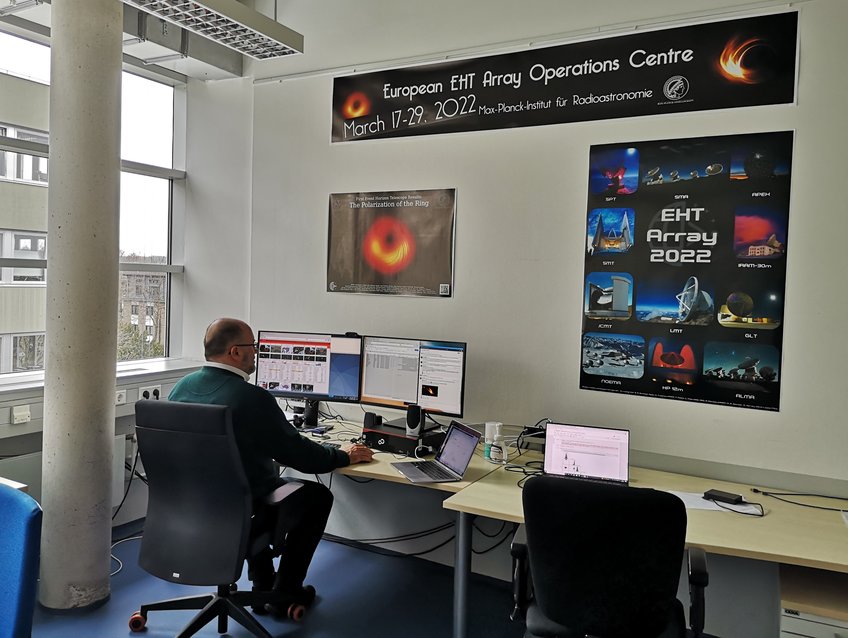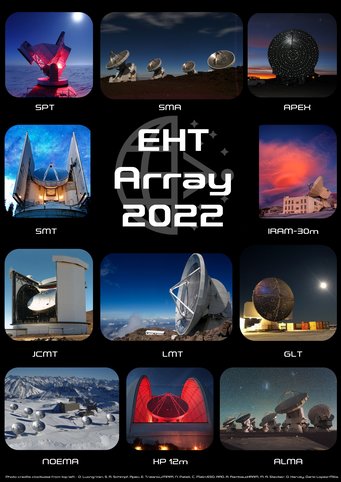Event Horizon Telescope 2022
Observing campaign in March 2022: world-wide radio telescope network performs observations with 11 participating telescopes
The Event Horizon Telescope (EHT) is an international collaboration with the goal of directly imaging the immediate environment of a black hole and thus testing Einstein's theory of general relativity in an extreme environment. Several European research institutes, including the Max Planck Institute for Radio Astronomy in Bonn, are participating in the observations as part of an international consortium. After the first observing campaigns in 2017, 2018, and 2021, the EHT will start its fourth campaign in March 2022, observing the center of the Milky Way as well as the galaxies Centaurus A, Messier 87, PKS 1510-089, Perseus A, Markarian 501, OJ 287, and 3C 454.3.

The EHT consortium consists of thirteen stakeholder institutions and about fifty affiliated institutions with about three-hundred individual members in Europe, Asia, Africa and America. Anton Zensus from the Max Planck Institute for Radio Astronomy (MPIfR) is the Board Founding Chairman of the collaboration and Sheperd S. Doeleman (Harvard, USA) is the Founding Director. Present Board Chairman and Project Director are, respectively, Colin J. Lonsdale (MIT, USA), and Huib J. van Langevelde (JIVE, The Netherlands).
The EHT project is funded by several agencies and institutions, among those the Max Planck Society through the MPIfR and the European Commission (projects BlackHoleCam, M2FINDERS, JETSET, and RadioNet).
The technique applied for the EHT observations is called Very Long Baseline Interferometry (VLBI). VLBI enables the highest resolutions in astronomy by coupling a number of radio telescopes distributed across different countries on Earth. This method is used for the investigation of the direct environment of supermassive black holes in active galactic nuclei, in particular jets of high-energy particles emitted from the central regions. In the framework of the EHT project it has become possible to directly image the central black holes in addition to the jets, as demonstrated in the nucleus of Messier 87, as announced on April 10, 2019. This is achieved by observations at shorter radio waves of only 1.3 mm wavelength. The resolution of the world-wide network of radio telescopes at that wavelength corresponds to a magnification factor of two millions or the size of a tennis ball in the distance to the moon.
To minimize the impact of the Earth’s atmosphere at this wavelength, the observations are only possible at high-altitude dry sites like the Atacama Desert in Chile, the Sierra Nevada in southern Spain, high volcanoes at Hawaii or even the South Pole.
Including the Atacama Large Millimeter Arrays (ALMA) with its sixty-four dishes in total provides a very high sensitivity since it is synthesizing a radio telescope with an equivalent diameter of 84 meters, superior to the usual millimeter-wave radio telescopes with 15 to 30 meters in diameter.
Previous observing campaigns took place in April 2017 (eight telescopes), April 2018 (the Greenland telescope was added), and April 2021 (the Kitt Peak 12-m telescope and NOEMA were added). The April 2019 and April 2020 campaigns were cancelled due to operational reasons and the CoViD-19 pandemic, respectively.
In the current campaign, scheduled to begin on March 17, 2022, seven nights of observations are planned in a time window ending March 29. A go/no-go decision will be made each evening at 20:00 CET. Remote Array Operation Centers have been established for continuous monitoring of the array. One of them is located at MPIfR and has the task to monitor the observations every day from 07:00 CET until the end of the observing night, when the last telescopes in America and Hawaii will be switched off.
The two main sources, Messier 87 and Sagittarius A*, are observed for three nights. Two nights are dedicated to Centaurus A, and the remaining sources are observed once each. Multiple sources may be combined on the same night. As in 2021, most observations will be made remotely, as travel restrictions are still in place due to the CoViD-19 pandemic.
VLBI data sets are analyzed in dedicated super computers, the so-called correlators. For the analysis of the EHT observations two correlators are used, at the Max Planck Institute for Radio Astronomy in Bonn (Head of the Correlator group: Helge Rottmann) and at Haystack Observatory in Haystack, Massachusetts, USA. The recording data bit rate since 2021 has been duplicated with respect to earlier campaigns, partially thanks to the implementation of a new data collecting system co-developed at the MPIfR, the Digital Base Band Converter 3 (DBBC3).
For an overall picture of the physics of black holes the observations are complemented by numerical simulations and tests with synthetical data. Some of those are performed at the High-Performance Cluster computing system at the MPIfR Correlator Center.

Telescope Network (Observations in March 2022)
- Atacama Pathfinder Experiment (APEX) in Chile, supervised by the MPIfR
- VLBI Observations: Alan Roy, Jan Wagner
- APEX Principal Investigator: Karl M. Menten (director at MPIfR)
- Atacama Large Millimeter Array (ALMA) in Chile, supervised by an international collaboration (including European Southern Observatory, ESO)
- VLBI observations from MPIfR: Helge Rottmann (as part of the ALMA Phasing Project)
- Greenland Telescope (GLT) in Thule, at the northwestern coast of Greenland
- IRAM 30-m telescope at Pico Veleta, Spain, supervised by the German-French-Spanish IRAM
- VLBI observations from MPIfR: Helge Rottmann (remote supervision); from IRAM among others: Pablo Torné
- IRAM Northern Extended Millimetre Array (NOEMA), at the Plateau de Bure near Grenoble, France
- Kitt Peak 12-m telescope (KP12m) from the Arizona Radio Observatory on the Kitt Peak in Arizona, USA
- James Clark Maxwell Telescope (JCMT) on Mauna Kea, Hawaii, USA, supervised by East Asian Observatory (Taiwan, China, Japan and South Korea)
- South Pole Telescope (SPT), supervised by an international collaboration (among others Ludwig Maximilian University, Munich)
- Submillimeter Array (SMA) on Mauna Kea, Hawaii, USA
- Submillimeter Telescope (SMT) from the Arizona Radio Observatory on Mount Graham, in Arizona, USA
- Large Millimetre Telescope (LMT) near Puebla, Mexico
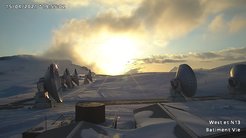
New telescopes such as the Africa Millimetre Telescope (AMT) are planned to join the array in the future.
Observed Targets (Observations in March 2022)
The EHT approved eight sources and a small sample of additional sources (survey mode) to be observed during this session. The eight sources to be observed are:
- The Galactic Centre, Sagittarius A*, in a distance of 27,000 light years in the constellation „Sagittarius“ (EHT project)
- The active galaxy Virgo A (Messier 87 or M 87), in a distance of 53 million light years in the constellation „Virgo“ (EHT project)
- The radio galaxy Centaurus A - in the southern constellation Centaurus at a distance of 13 million light years (PI Maciek Wielgus, research associate at the MPIfR)
- The radio galaxy PKS 1510-089 in the constellation Libra at a distance of 100 million light years (PI Nicholas R. MacDonald, research associate at MPIfR)
- The radio galaxy NGC 1275 (also known as 3C 84 or Perseus A), at the center of the Perseus galaxy cluster, at a distance of 247 million light years, in the constellation Perseus (PI Georgios F. Paraschos, PhD student at MPIfR)
- The blazar Markarian 501 at a distance of 450 million light years, in the constellation Hercules (PI Shoko Koyama, former postdoc at MPIfR, now professor at Niigata University in Japan)
- The distant quasar OJ 287 with a redshift of 0.306; the emitted light took 3.36 billion years to arrive at Earth; the galaxy most likely hosts a binary supermassive black hole and is located in the constellation Cancer (PI José L. Gómez of the Instituto de Astrofísica de Andalucía in Granada, Spain)
- The powerful quasar 3C 454.3 with a redshift of 0.859, whose light took 6.91 billion years to reach Earth, i.e., we observe the Universe when it was about 50% of its present age. It is also known as the "crazy diamond" and is located in the constellation Pegasus (PI Efthalia Traianou, of the Instituto de Astrofísica de Andalucía in Granada, Spain, which is also affiliated with the MPIfR).
- Source Survey: A small sample of active galaxies that can be used as candidates for black hole imaging is being studied (PI Neil Nagar, Universidad de Concepción in Chile).
Further active galaxies (like 3C 279 or 4C +01.28) will be used as calibration sources. Sgr A* in the centre of our Milky Way and the central source of galaxy Messier 87 in the Virgo galaxy cluster represent the two key sources for the EHT project.
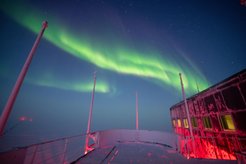
Partner and selected contact persons
In stakeholder institutions
- Max-Planck-Institut für Radioastronomie, Bonn, Germany
- J. Anton Zensus (Director at MPIfR, EHT Board Founding Chairman) – azensus@mpifr.de
- Michael Kramer (Director at MPIfR, BHC Main Investigator) – mkramer@mpifr.de
- Karl M. Menten (Director at MPIfR, APEX Principal Investigator) – kmenten@mpifr.de
- Thomas P. Krichbaum (Scientist) – tkrichbaum@mpifr.de
- Eduardo Ros (Scientist) – ros@mpifr.de
- Helge Rottmann (VLBI Technology Division Head, Correlator Group, Supervisor of IRAM and ALMA EHT Observations) – hrottmann@mpifr.de
- Alan Roy (Supervisor of APEX EHT Observations) – aroy@mpifr.de
- Jan Wagner (Correlator team) – jwagner@mpifr.de
- Goethe University, Frankfurt, Germany
- Luciano Rezzolla (BHC Main Investigator) - rezzolla@th.physik.uni-frankfurt.de
- Radboud Universiteit Nijmegen, The Netherlands
- Heino Falcke (BHC Main Investigator) - H.Falcke@astro.ru.nl
- Institut de radioastronomie millimétrique (IRAM), Grenoble, France, and Granada, Spain
- Karl Schuster (Director and EHT Board Member) - schuster@iram.fr
- Miguel Sánchez Portal (IRAM 30-m Statiojn Head) - msanchez@iram.es
- Pablo Torne (IRAM 30-m friend of VLBI) – torne@iaa.es
- Haystack Observatory, Massachusetts Institute of Technology, MA, USA
- Colin J. Lonsdale (EHT Board Chairman) – cjl@haystack.mit.edu
- Mike Hecht (EHT Board Secretary) - mhecht@haystack.mit.edu
- Smithsonian Astrophysical Observatory, Harvard University, MA, USA
- Sheperd S. Doeleman (EHT Founding Director) - sdoeleman@cfa.harvard.edu
- Perimeter Institute, Waterloo, ON, Canada
- Large Millimeter Telescope, Mexiko
- University of Chicago, IL, USA
- University of Arizona, Tucson, AZ, USA
- Remo Tilanus (EHT Operations Manager) - rtilanus@arizona.edu
- Academia Sinica Institute of Astronomy and Astrophysics, Taipei, Taiwan
- Geoff C. Bower (EHT Project Scientist) - gbower@asiaa.sinica.edu.tw
- National Astronomical Observatory of Japan, Tokyo, Japan
In affiliated institutions:
- Joint Institute for VLBI-ERIC, Dwingeloo, The Netherlands
- Huib Jan van Langevelde (EHT Project Director) - langevelde@jive.eu
- Instituto de Astrofísica de Andalucía, Granada, Spain
- Rocco Lico (EHT Management Team Secretary) – rlico@iaa.es
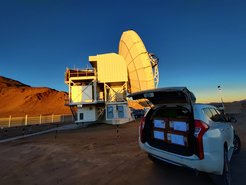
Links to participating telescopes
In stakeholder institutions
- Atacama Pathfinder Experiment (APEX)
http://www.apex-telescope.org/ - Atacama Large Millimeter Array (ALMA)
http://www.almaobservatory.org/ - Greenland Telescope (GLT)
https://www.asiaa.sinica.edu.tw/project/vlbi.php - IRAM 30-m Telescope on Pico Veleta
https://www.iram-institute.org/EN/30-meter-telescope.php?ContentID=2&rub=2&srub=0&ssrub=0&sssrub=0IRAM - IRAM Northern Extended Millimeter Array (NOEMA)
https://www.iram-institute.org/EN/noema-project.php?ContentID=9&rub=9&srub=0&ssrub=0&sssrub=0 - Kitt-Peak 12-m telescope (KP12)
http://aro.as.arizona.edu/?q=facilities/12m-telescope - South Pole Telescope (SPT)
http://pole.uchicago.edu/ - James Clark Maxwell Telescope (JCMT)
http://www.eaobservatory.org/jcmt/ - Submillimeter Array (SMA)
http://www.cfa.harvard.edu/sma/ - Submillimeter Telescope (SMT)
http://aro.as.arizona.edu/?q=facilities/submillimeter-telescope - Large Millimeter Telescope (LMT)
http://www.lmtgtm.org/
Telescope in planning for future campaigns:
- Afrika-Millimeter-Telescope (AMT)
http://www.ru.nl/amt/
